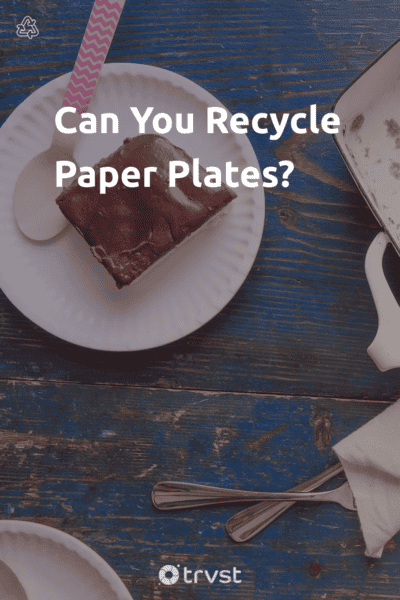Can You Recycle Paper Plates? Are The Compostable?
In today’s world of fast food and eating out, paper plates have become a norm. We use them in outdoor gatherings, picnics, and get-togethers. They are also easy to clean up and dispose of.
Paper plates differ from plastic plates or ceramic plates. As the name implies, manufacturers make paper plates using cardboard or paper sourced from trees.
The question you may ask is, since paper plates come from trees, can you recycle them? The simple answer is yes and no. Whereas you can recycle some paper plates, you cannot recycle most of them due to contamination or plastic coatings.
Read on as we explore the intricacies of recycling paper plates and how best to get rid of them.
Are paper plates recyclable?

So can we recycle paper plates? The answer isn’t so straightforward. Paper plates with no contamination with food waste can easily be recycled, provided your local facility accepts them. Whether they do or not largely depends on their ability to process paper plates with plastic coatings.
However, if a paper plate contains food residue or oil residue, in that case, it can contaminate the paper fibers and affect the entire recycling process, leading to a waste of energy and money. This is why most recycling programs and municipalities don’t accept paper plates for recycling.
This is also true for recycling pizza boxes. Even though they come in corrugated cardboard, most recycling facilities do not accept pizza boxes because of food contamination.
Interestingly, even unused napkins, paper towels, eco-friendly toilet paper, facial tissue, and other paper products are challenging to recycle due to their lightweight, making mechanical processing a challenge. However, paper towel cores and tissue boxes are recyclable materials.
Furthermore, paper plates usually come with a coating that prevents the paper plate from soaking up grease. Usually, a paper recycling facility cannot separate the coating from the paper plate, which further complicates things.
However, some recycling facilities may accept used clean paper plates. As such, curbside recycling can vary, and it is worth checking to find out the local centers that accept used paper plates.
Are paper plates bad for the environment?
If you use paper plates a lot, you may be wondering what impact it has on the environment. Making a paper plate involves many processes, including cutting down trees.
However, if we compare plastic and paper plates, paper plates are better for the environment. This is because plastic causes more environmental damage.
However, there are a few reasons these plates are not the best option for the environment.
Deforestation
According to Global Forest Resource Assessment, we cut down about 80,000 to 160,000 trees every day around the world to make paper and paper products like tissues and towels. Unfortunately, continuous forestation distorts climatic patterns significantly. In addition, the paper industry also contributes significantly to air pollution.
Imbalanced ecosystem & loss of habitats
Deforestation poses far more risks to our environment than we think. Our ecosystem consists of plants and animals, which exist to create a balanced ecosystem. With the felling of trees comes the loss of habitat for animals. It also causes a lack of protection for small plants in the forest.
Plants and animals are not the only ones who feel the impact of deforestation. We also get a decline in the supply of oxygen. Worse still, the environment is prone to more natural disasters like erosion.
Difficult to recycle
Your curbside program may not accept paper plates because most of them contain grease and particles which can contaminate the entire recycling stream. This means that more paper plates will end up being thrown in the trash and landfills.
Pollution
There’s a lot that comes with making plates made of paper. The machinery used contributes significantly to adding harmful gases to the environment, causing air pollution.
Manufacturers also add chemicals when making papers which can contribute to health issues and potentially expose workers to chronic diseases. Finally, paper plates that don’t end up recycled and up in landfills contribute to environmental waste and pollution.
How to recycle paper plates
Paper plates free of food waste can easily be recycled. Here’s what the recycling process looks like:
- Collect your clean plates and take them to the recycling plant. You want to ensure that your paper plate is free of any food materials.
- Next, recyclers will carefully sort the paper plates out and remove any contaminated plates.
- Next, facilities will convert them into pulp through the use of water and other chemicals.
- Then, they will remove any unwanted material from the pulp.
- And remove any adhesives or ink on the plate
- Now, recyclers will add bleach to give the paper its white color.
- When all is done, they will roll the pulp and cut them into different sizes
You will need to check with your local recycling team to determine if you can dump your used paper plates in your curbside bin, as not all facilities can undertake the outlined process.
Ways to reuse your paper plates

To reduce the environmental impact of paper plates, you have the option of reusing them if they cannot be recycled. Here are some ways you can put your paper plates to good use:
Clean and reuse
Who says you have to throw away all your paper plates? If you have plates that are not heavily stained - perhaps you served dry snacks. You can clean them using dish soap bars and water or give them a quick wipe and use them again.
Packaging
You can use your old paper plates as a basket to store snacks like cookies and other baked food. You can also use them to store small office equipment like eco-friendly pens and office pins, paintbrushes, erasers, and so on.
Arts and crafts
Your used paper plates can be separated, washed, and used for some arts and crafts. You can paint them and use them as wall art.
What can you use instead of paper plates?
Instead of using a paper plate, you can opt for your regular reusable plates. You can be sure that washing them will have a much lower impact.
For more disposable options, you may consider bamboo cutlery sets and plates made from sustainable bamboo. You can wash them and reuse them a few more times before disposing of them. Once they are old, you can easily add them to your compost pile.
Can you compost paper plates?
Since you can not add most paper plates to a recycling bin because of grease contamination, you may wonder if you can compost paper plates. Well, since they come from paper, you can put any paper plate up for composting that has a “PLA or Compostable” label.
You want to rip them into smaller chunks before adding them to your garden to aid decomposition. It can take anywhere from 45 days to 180 days to completely turn into finished compost.
Are paper plates biodegradable?
Paper plates come with significant environmental damage. However, they are fully biodegradable. This is because they come from trees, and trees are organic. This means that they can decay and provide valuable nutrients to the soil.
Plates that manufacturers coat with plastics may take much longer to biodegrade, and the plastic coating can last for years and years.
Typically, the actual paper plates take a short period, usually a few months, to decompose when placed under the right weather.
Conclusion
Paper plates are very convenient, especially for special occasions that involve a good number of people. However, these plates can only be recycled if they have not been contaminated with food.
Once contaminated, you can try out other methods like reusing or composting them for your garden.
Jen’s a passionate environmentalist and sustainability expert. With a science degree from Babcock University Jen loves applying her research skills to craft editorial that connects with our global changemaker and readership audiences centered around topics including zero waste, sustainability, climate change, and biodiversity.
Elsewhere Jen’s interests include the role that future technology and data have in helping us solve some of the planet’s biggest challenges.

